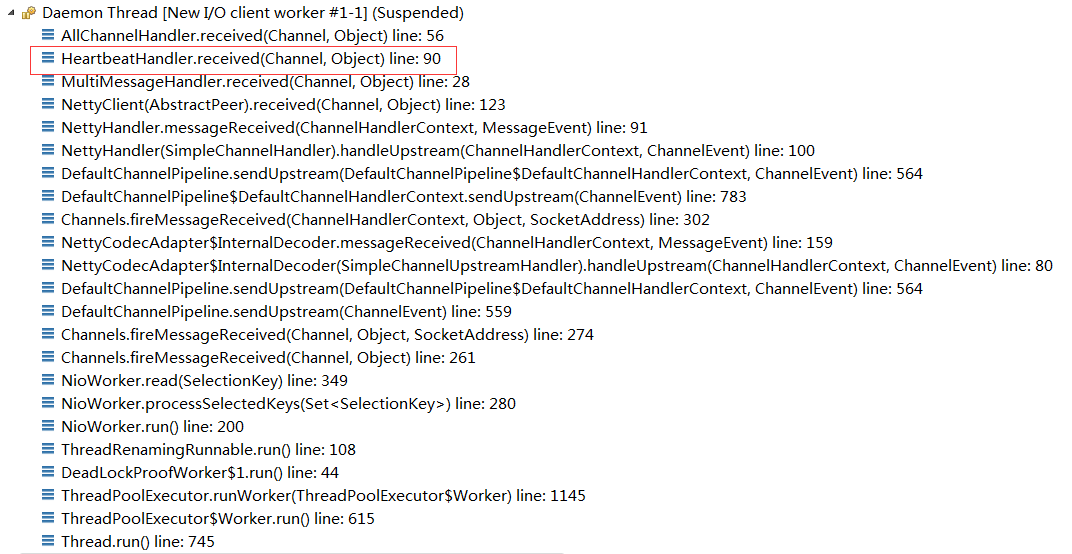HeartBeatTask 类封装了心跳定时任务,需要了解的是 provider 和 consumer 都有可能发送心跳。
final class HeartBeatTask implements Runnable { private static final Logger logger = LoggerFactory.getLogger( HeartBeatTask.class ); private ChannelProvider channelProvider; private int heartbeat; private int heartbeatTimeout; HeartBeatTask( ChannelProvider provider, int heartbeat, int heartbeatTimeout ) { this.channelProvider = provider; this.heartbeat = heartbeat; this.heartbeatTimeout = heartbeatTimeout; } public void run() { try { long now = System.currentTimeMillis(); for ( Channel channel : channelProvider.getChannels() ) { if (channel.isClosed()) { continue; } try { Long lastRead = ( Long ) channel.getAttribute( HeaderExchangeHandler.KEY_READ_TIMESTAMP ); Long lastWrite = ( Long ) channel.getAttribute( HeaderExchangeHandler.KEY_WRITE_TIMESTAMP ); if ( ( lastRead != null && now - lastRead > heartbeat ) || ( lastWrite != null && now - lastWrite > heartbeat ) ) { Request req = new Request(); req.setVersion( "2.0.0" ); req.setTwoWay( true ); req.setEvent( Request.HEARTBEAT_EVENT ); channel.send( req ); } if (lastRead != null && now - lastRead > heartbeatTimeout) { //如果是 consumer 端 if (channel instanceof Client) { ((Client)channel).reconnect(); } else { // provider 端 channel.close(); } } } catch ( Throwable t ) { } } } catch ( Throwable t ) { logger.warn( "Unhandled exception when heartbeat, cause: " + t.getMessage(), t ); } } interface ChannelProvider { Collection<Channel> getChannels(); } }
对于 consumer,是在 HeaderExchangeClient 类中启动心跳定时器,而 provider,则是在 HeaderExchangeServer 中启动心跳定时器。
consumer发送请求时,更新 lastWrite 值,接收响应时,更新 lastRead 值。心跳定时器定时检查 lastRead 和 lastWrite,发送心跳、重连。
public class HeaderExchangeClient implements ExchangeClient { private static final ScheduledThreadPoolExecutor scheduled = new ScheduledThreadPoolExecutor(2, new NamedThreadFactory("dubbo-remoting-client-heartbeat", true)); // 心跳定时器 private ScheduledFuture<?> heatbeatTimer; private int heartbeat; private int heartbeatTimeout; public HeaderExchangeClient(Client client){ if (client == null) { throw new IllegalArgumentException("client == null"); } this.client = client; this.channel = new HeaderExchangeChannel(client); String dubbo = client.getUrl().getParameter(Constants.DUBBO_VERSION_KEY); //heartbeat = 60000 this.heartbeat = client.getUrl().getParameter( Constants.HEARTBEAT_KEY, dubbo != null && dubbo.startsWith("1.0.") ? Constants.DEFAULT_HEARTBEAT : 0 ); //heartbeatTimeout = 180000 this.heartbeatTimeout = client.getUrl().getParameter( Constants.HEARTBEAT_TIMEOUT_KEY, heartbeat * 3 ); if ( heartbeatTimeout < heartbeat * 2 ) { throw new IllegalStateException( "heartbeatTimeout < heartbeatInterval * 2" ); } startHeatbeatTimer(); } public ResponseFuture request(Object request) throws RemotingException { return channel.request(request); } private void startHeatbeatTimer() { stopHeartbeatTimer(); if ( heartbeat > 0 ) { heatbeatTimer = scheduled.scheduleWithFixedDelay( new HeartBeatTask( new HeartBeatTask.ChannelProvider() { public Collection<Channel> getChannels() { return Collections.<Channel>singletonList( HeaderExchangeClient.this ); } }, heartbeat, heartbeatTimeout), heartbeat, heartbeat, TimeUnit.MILLISECONDS ); } } }
在 HeartbeatHandler 类中设置 lastRead 和 lastWrite 值:
public class HeartbeatHandler extends AbstractChannelHandlerDelegate { //省略其他代码 private void setReadTimestamp(Channel channel) { channel.setAttribute(KEY_READ_TIMESTAMP, System.currentTimeMillis()); } private void setWriteTimestamp(Channel channel) { channel.setAttribute(KEY_WRITE_TIMESTAMP, System.currentTimeMillis()); } }
设置 lastWrite 的调用栈:

设置 lastRead 的调用栈:
